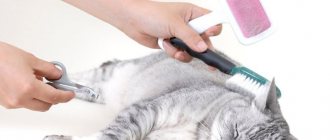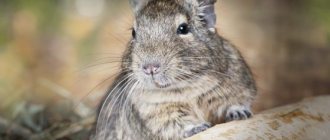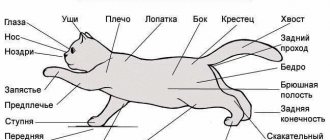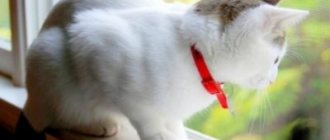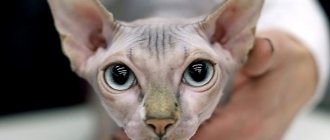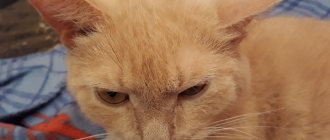What do lice eaters look like?
This type of ectoparasite belongs to the order of lice eaters. Sometimes lice eaters are confused with mites, but unlike the latter, they are not able to penetrate the skin and live at the base of the fur. Only one species of these insects is found in cats, namely Felicola subrostratus. Parasitic infection in this case is diagnosed as trichodectosis.
Lice eaters in cats look like lice. They are characterized by a small body size, the length of which barely reaches 2 mm. The body is oval in shape, and the head is large, quadrangular in the form of a shield. The color of the insect is light yellow and translucent, so it is very difficult to detect parasites in a pet’s fur.
Lice eaters, like fleas, have three pairs of legs, at the ends of which there are microscopic hooks. They help the insect cling to the skin and fur of the animal. They have no wings.
Lice eaters belong to the category of warm-blooded parasites. Outside the host's body, they can live no more than 5 days.
Appearance
Features of anatomy
The mouthparts of lice eaters are of the gnawing type. The basis of their nutrition is keratin particles of skin, wool, as well as secretions from the sebaceous glands. Lice eaters can drink a pet's blood only if there are open wounds and scratches on the skin. Short antennae in the frontal part of the insect serve as an organ of touch.
Reproduction
Lice eaters are distinguished by their high ability to reproduce offspring. One female lays up to 100 eggs at a time and glues them at the base of her hair with a special secretion. After 7-10 days, lice eater larvae emerge from them.
The process of transforming them into an adult takes 2-3 weeks, during which 3 molts occur. After this, the insect is able to independently reproduce offspring.
The danger of lice-eating cats for human health
A person does not have to worry about such a parasite settling on his body. The latter will not be satisfied with the scarcity of hair. However, if there is an infected animal in the house, it is a dangerous resident for all inhabitants, so the fight must be carried out in a timely manner.
Close contact with a sick animal can create a situation where a person may accidentally receive a lice bite. This is fraught with the risk of becoming infected with fungi and bacteria. Allergies may develop.
Important! Children should be protected from contact with an infected animal until it has fully recovered. Because children are particularly vulnerable.
Why are they dangerous?
In the course of its life, the cat's hair eater provokes the development of allergies and dermatitis in the pet. The obsessive itching of the skin in the areas where these insects are located gradually intensifies, leading to scratching and abrasions into which bacteria enter. As a result, an inflammatory process develops, which is accompanied by ulcers, redness and swelling of the skin. Against this background, the cat’s fur deteriorates, concomitant chronic diseases in the animal’s body worsen, and health deteriorates.
Cat and dog lice eaters are intermediate hosts of parasitic worms and worms. They also carry Rickettsia and Bartonella on their bodies, which cause infectious diseases.
Infection of a kitten or puppy with lice eaters can negatively affect further development and even cause death. After all, the immature immunity of animals at an early age is not always able to withstand such a load.
Causes
There can be many reasons for the appearance and ways of infection by lice eaters, among them the most common are:
- Having direct contact with an already infected animal. At the same time, a cat can pick up lice eaters not only from its relatives, but also from dogs.
- Hunting and catching infected rodents , which can also be infected with lice eaters.
- Transmission of parasites to newborn kittens from an infected mother cat.
- Poor quality of living conditions for the cat , their non-compliance with established sanitary standards.
- Increased levels of air humidity or excess dampness in rooms in which the cat spends a significant amount of time.
- Lack of complete and balanced nutrition , incorrectly selected food or poorly designed diet.
- Weakening of the immune system , which can be caused by a large number of third-party factors, including poor nutrition or previous severe forms of various diseases.
Routes of infection
Lice eaters in cats appear in most cases through direct contact between a sick and healthy animal. Less often this happens through an intermediate household item such as a comb or bedding. Kittens mainly become infected from their mother, and animals walking on the street from rodents.
Unbalanced diet
Provoking factors contributing to the rapid development of trichodectosis:
- unbalanced diet;
- crowded content;
- increased air humidity;
- weakened immunity.
Transmission routes and risk factors
Flea drops for cats: remedy, tablets
The occurrence of lice beetles in cats is facilitated by the contact method of infection. This can include:
- Direct contact with relatives. Lice can be transmitted to a healthy animal during play, during sexual intercourse or during a fight.
- Contact with various objects: dirty clothes and shoes of people, dirty bedding, uncleaned combs.
- Family contact. Adult cats can infect their kittens.
- Hunting for rodents. This happens less frequently, but mice and rats can also carry pests.
Fighting is one of the ways of transmitting parasites
Signs of the disease
You can recognize a parasitic infestation in a pet by its characteristic symptoms. When lice eaters appear, the animal’s behavior and the appearance of its fur changes.
Main features:
- obsessive itching;
- non-healing wounds, redness on the skin;
- peeling, dandruff;
- receding hairline,
- the fur becomes dull and falls out in clumps;
- appetite decreases;
- restless behavior.
The symptoms and treatment of lice eaters in cats, regardless of the breed of the pet, are the same.
Preventive measures
It is quite simple to protect your pet from ectoparasites if you strictly follow a small set of rules, which include:
- undergoing routine examinations by a veterinarian, which will allow timely tracking of the ailment that has arisen;
- carrying out preventive treatment of the cat using insecticides from the list presented above;
- If there is a possibility of your pet coming into contact with infected animals, it is necessary to put an insecticidal collar on the cat, which will serve as a protective barrier.
A flea and tick collar helps keep your cat safe when walking.
In addition to the indicated preventive measures, it is important to take care of maintaining your pet’s immunity. As already mentioned, lice eaters take root best on weakened animals, while cats in good health are less likely to be infected by these parasites.
Treatment
If alarming signs appear, you need to conduct a thorough examination of your pet, paying special attention to the area near the tail, where parasites are usually localized in large numbers.
To see lice eaters, you need to examine the fur at its base using a magnifying glass. You can also identify insects by holding your pet under an incandescent lamp for about 5 minutes to warm up the skin. After this time, the lice eaters will begin to crawl up the fur en masse. After confirming the diagnosis, you need to start complex therapy.
Drops
When using these products against lice, you need to apply the working solution to dry skin of the back, neck and at the base of the back of the head, rubbing lightly. After the procedure, you cannot bathe the cat for 3 days.
Leopard
Effective drops for cats against lice:
- Leopard;
- Advantage;
- Pfizer;
- Stronghold.
Sprays
To treat trichodectosis, you can also use special sprays. It is necessary to spray such a drug against lice on the animal’s dry fur from a distance of 15 cm, avoiding contact with the nose, eyes and mouth, and bathe after 2-3 hours.
During this time, you need to make sure that your pet does not lick the spray from its fur or put a protective collar on it. If necessary, the procedure should be repeated after a week.
Effective drugs:
- Greenfort;
- Bayer;
- Rosagroservis.
Greenfort
Emulsions
These remedies also help cure trichodectosis. Before use, the emulsion must be diluted with water, and only then used for therapy. To remove lice-eaters, the working solution, like drops, must be applied to places inaccessible for licking.
Popular drugs:
- Impex;
- Bayer;
- Merial;
- Pfizer;
- Bionics.
Bayer products
Shampoos
You can get rid of lice eaters, as well as other types of parasites, by using shampoos containing insecticides. However, this remedy is effective only when the number of insects is small, and also as a preventive measure. In case of mass reproduction of lice eaters, it should be used in combination with other drugs.
The product should be applied to the cat's damp fur, lathered slightly and left for 5 minutes. Then rinse with plain water.
Popular shampoos:
- Phytoelite;
- Lugovoy;
- Celandine;
- Ms. Kiss.
Ms. Kiss
Antiparasitic collars
This product is a tape that is impregnated with an insectoacaricidal composition. When you put a collar on your pet, the toxic substance accumulates in the sebaceous glands, the top layer of skin and hair follicles, without penetrating into the bloodstream. The period of its protective effect against lice in cats is 2-8 months, depending on the brand.
Attention! Such products are contraindicated for kittens under six months of age, as well as for pregnant and lactating cats.
Effective anti-parasitic collars:
- Multix;
- Preventeffcat.
Folk remedies
At home, in the absence of special medications, you can use folk remedies to treat cats against lice. They need to be prepared using herbs that have a pungent odor that has a repellent effect.
Some of the things you can do to treat a cat against lice infestations include:
- sagebrush;
- wild garlic;
- chamomile;
- sequence;
- celandine.
To prepare a decoction based on any herb, you need to pour 50 g of raw material into 1 liter of water and boil for 15 minutes over low heat. After cooling, it can be used to bathe the animal. This method of therapy can be used as an additional treatment to the main treatment and as a preventive measure.
Cheremsha
Symptoms
Signs of infestation by lice eaters and fleas are similar: constant scratching turns the skin into a rough, rough and inflamed surface.
Regulars of the microbial communities of the cat's surface - fungi join the lice and increase skin inflammation. Hair falls out, skin scales form, which are happily eaten by insects.
Lice eaters, like fleas, are carriers of a significant number of diseases, the symptoms of which can be layered on existing dermatitis and alopecia. The weakening of protective mechanisms creates conditions for the uncontrolled development of subcutaneous mites.
In animals predisposed to allergic reactions, lice eaters cause rashes, swelling, and suppuration. If a cat suffers from a chronic disease, an insect infestation can cause an exacerbation.
Dermatitis and baldness
Diagnostics
Symptoms of infestation of cats by lice, fleas and lice are similar. There is no need to conduct laboratory tests to make an accurate diagnosis. Trichoderma are small, <2 mm long creatures that are very thermophilic. If you place a cat in the sun, or close to the source of the body, all the parasites will move to the ends of the hairs. Other insects do not have thermophilic preferences.
Lice eaters are drawn to warmth
Caring for a sick animal
A cat infected with trichodectosis does not require special care. There is also no need for nutritional correction. After the first use of medications, the pet’s well-being, as a rule, improves. To speed up the animal’s recovery, after identifying lice eaters, you must:
- carry out wet cleaning of the home by treating the surfaces with which the infected animal has come into contact with a napkin moistened with 2% Neostomozan, Ecocide or Ectomin;
- vacuum and steam toys, bed, scratching post, pet play structure;
- treat wounds with an antiseptic, for example Chlorhexidine, best done with sterile gauze;
- After finishing treatment, give the cat an anthelmintic.
If a cat is diagnosed with trichodectosis, it must be isolated from other pets. This measure will prevent them from becoming infected.
Are lice-eaters transmitted to people?
After the owner discovers lice-eaters in his pet, he, for natural reasons, begins to worry not only for the animal, but also for himself, wondering whether the disease is transmitted to humans or not.
Since lice eaters love warmth and quickly die without it and food, these parasites try not to leave the animal. And in general, they are not interested in a person, since he does not have fur, which is why the need for warmth will not be satisfied. Therefore, they cannot settle on a person.
And yet, there is a certain threat from lice eaters to people. They are carriers of parasitic worms and infectious diseases, which can also infect humans.
Lice eaters in cats are an unpleasant problem, but a completely solvable one. The main thing is to detect them in time and take action, otherwise complications may arise for both the animal and its owner. It is necessary to properly care for your pet and take preventive measures against parasites.
In this case, the likelihood of cats getting sick will be minimal. If this happens anyway, the pets must be taken to the vet immediately. The specialist will conduct an examination and prescribe appropriate medications.

